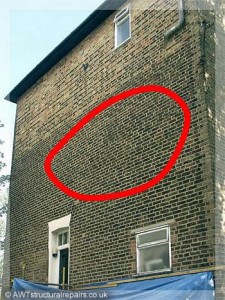Bowing Wall
This site has been designed with our domestic customers in mind, we have much more detailed technical information on our main commercial/trade website.
There are a number of common potential causes for bowing brickwork.
- Deterioration of the mortar holding the brickwork together
- Cracking bricks
- Insufficient structural strength ( a common problem in Victorian properties)
- Lifting by rusting  wall ties
Below are some case studies to illustrate how AWT can repair bulging brick walls.
 Victorian Semi with Bowing Wall
Victorian Semi with Bowing Wall
The side wall of this Victorian property was bulging at the second floor level although there was no significant cracking in the brickwork.  The third floor brickwork had been rebuilt at some point but the underlying problem had not been solved.
AWT diagnosed insufficient restraining of the wall. It is common for Victorian properties to have walls built with snapped header bricks because the builders wanted to save money on the expensive facing bricks! The result is a wall which lacks adequate restraint and so the brickwork bows over time.
AWT introduced reinforcements into the horizontal mortar bed joints. Strong stainless steel lateral restraints were added to tie the wall back to the timber work of the house. Walls ties were used to stabilise loose bricks. Finally the AWT team re-pointed the area to match the existing colour of the mortar.
Bowing Cavity Wall
 This 1950s house had a noticeable bulge in the gable wall. It also had horizontal cracks in the mortar joints and the joints were opening up.
This 1950s house had a noticeable bulge in the gable wall. It also had horizontal cracks in the mortar joints and the joints were opening up.
AWT inspected the wall ties and found they were heavily corroded.
The bowing wall was due to the failure of the wall ties. The cracking was due to the expansion of the wall ties as they rusted.
Remedial wall ties were installed and the old wall ties were isolated to prevent further damage.
The structural strength of the wall was reinstated using special bed joint reinforcements. Stainless steel lateral restraints were also embedded in the masonry.
The localised cracks were stitched together and finally the pointing was made good with matching mortar.